Reviews Books
Dec 19, 2017

Dancing with the King: The Rise and Fall of the King Country, 1864–1885
Nā Michael Belgrave
Auckland University Press 2017
RRP: $65.00
Review nā Te Hau White
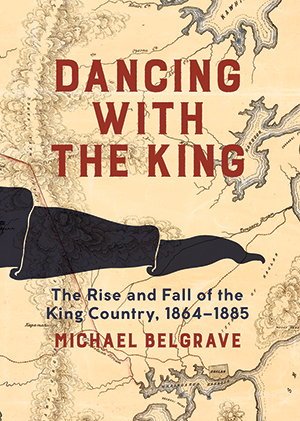 Dancing with the King explores a lesser-told yet immensely significant chapter of New Zealand’s history. It provides a fascinating insight into the machinations of the settler government, and the Kīngitanga movement in Waikato.
Dancing with the King explores a lesser-told yet immensely significant chapter of New Zealand’s history. It provides a fascinating insight into the machinations of the settler government, and the Kīngitanga movement in Waikato.
The book covers the events of the exile of Tāwhiao, the second Māori King, following the final defeat of the Land Wars at Ōrākau, when the King and his supporters were forced into armed isolation, and operated for 20 years as an independent state. The narrative maintains a central focus on the actions of Tāwhiao and the Kīngitanga, whilst weaving in the other related historical figures and events of the time. It was especially interesting to see the focus placed on the rangatira of Tainui and Maniapoto, and the influence they had over the King, and also in maintaining the peace after the incredible bloodshed of the Land Wars. The “big players” such as Tāwhiao are complemented with the actions and perspective of lesser-known rangatira such as Rewi Maniapoto, Manuhiri, and, Wahanui Huatere, who had an immense yet underrated impact on the history of the North Island.
Belgrave provides remarkably specific details of the interactions both within and external to the Kīngitanga. The focus is on the years in exile following the war, through to the détente between the Kīngitanga and the settler government.
An interesting dimension of this book is the intricacies of the power structures of the time, and the dynamics between the various hapū and iwi of the central North Island. The role and importance of other pivotal Māori leaders such as Te Kooti and Tītokowaru provide useful context surrounding the societal structure of te ao Māori at this time, and the lack of a unified identity.
Whilst this is a fascinating read, it does require a robust prior knowledge of the wider context of the land wars and New Zealand in the 1800s. Due to its tight focus on Te Rohe Pōtae and the Kīngitanga movement, for people like me who are unfamiliar with the locations and the history of the region, it does require more time to understand. For those with whakapapa to the iwi of Waikato-Tainui and Maniapoto, it is a must-read to understand the struggle of those tūpuna.
This book is a great historical read for people wanting an in-depth understanding of the Kīngitanga, Te Rohe Pōtae (the King Country), and the wider historical context of the North Island in the late 1800s. The significance of the events in this book cannot be understated, and hopefully one day the content of this book will be common knowledge for all New Zealanders.
 Te Hau White (Ngāi Tahu – Ngāti Huirapa – Ngāi Tupoto) is a Policy Advisor at Te Rūnanga o Ngāi Tahu. He was raised in Ōtautahi and Hokianga.
Te Hau White (Ngāi Tahu – Ngāti Huirapa – Ngāi Tupoto) is a Policy Advisor at Te Rūnanga o Ngāi Tahu. He was raised in Ōtautahi and Hokianga.
Aotearoa: The New Zealand Story
Nā Gavin Bishop
Picture Puffin 2017
RRP: $40.00
Review nā Awhina McGlinchey rātou ko Hineātea (9) ko Tūnui Alexander (7)
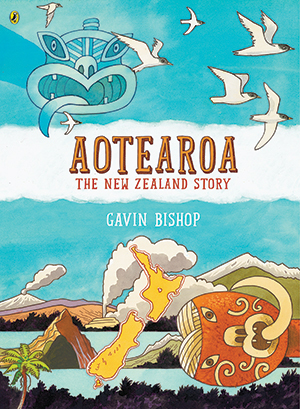 This is a children’s book with small snippets of history spanning from the beginning of history through to present day Aotearoa, cramming in as much as it can from the time in between. Both children were first drawn to the artwork in the book and looked through all of the pictures before even looking at the text.
This is a children’s book with small snippets of history spanning from the beginning of history through to present day Aotearoa, cramming in as much as it can from the time in between. Both children were first drawn to the artwork in the book and looked through all of the pictures before even looking at the text.
The book uses one-sentence descriptions placed over double-page pictorial spreads to present major historical events throughout a rather expansive timeline. This gives the book a limited ability to offer a complete story. However, it did prompt the children to start discussions with Māmā. Supplying an answer usually required Māmā to pull in the other adults in the house for an “all in” whānau discussion. As the children get older and reading time becomes more of a solo activity, it is always special when a book can bring three generations together to kōrero.
Hineātea liked the fact that the book covered both Māori and European history in New Zealand, as she identifies with both due to having a Māori Māmā and Pākehā Pāpā. Her favourite page was the one featuring a picture which names all the waka, and shows the voyage across Te Moana-nui-a-Kiwa. Hineātea also found it fun learning new Māori words, particularly names for some of the bugs, which she hadn’t heard before. The natural attractions page made her want to visit all of the places described, “even the Pink and White Terraces even if they can’t be seen anymore.” Her overall thoughts on the book? “It is fascinatingly awesome and a great book for kids.”
Tūnui really enjoyed all the pictures and information, although he was drawn to the pages about war (as many seven-year-old boys would be). He was interested in the well-known New Zealanders page, as well as all the other people he got to read about throughout the book. “They were all pretty cool. Well, except for Adolf Hitler.” His final thoughts were “I loved the book and think other kids should read it.”
 Hineātea (9) and Tūnui (7) Alexander are Ngāi Tahu tamariki that whakapapa to Moeraki. They live in Ōtautahi in an intergenerational home with their Māmā Awhina, as well as their taua and pōua, Rangi and Trevor McGlinchey.
Hineātea (9) and Tūnui (7) Alexander are Ngāi Tahu tamariki that whakapapa to Moeraki. They live in Ōtautahi in an intergenerational home with their Māmā Awhina, as well as their taua and pōua, Rangi and Trevor McGlinchey.
Huia Short Stories 12 – Contemporary Māori Fiction
Huia Publishers 2017
RRP: $30.00
Review nā Gerry Te Kapa Coates
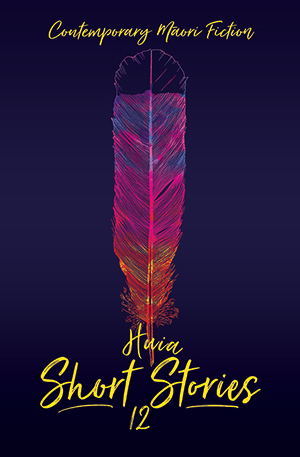 The introduction by Robyn Bargh – who initiated the Huia Awards with her partner Bryan – seems to indicate these have now morphed into a competition for new writers, or others who have “already begun building a place for themselves in New Zealand literature.”
The introduction by Robyn Bargh – who initiated the Huia Awards with her partner Bryan – seems to indicate these have now morphed into a competition for new writers, or others who have “already begun building a place for themselves in New Zealand literature.”
This 12th edition has only 24 finalists compared with upwards of 30 in past editions. The odd thing now is that several writers have multiple stories in this book – Lauren Keenan (winner of the Best Short Story in English category) has six, and Shirley Simmonds has four. As for Ngāi Tahu writers, only Pere Durie acknowledges this in his multiple roots. Another trend seems to be the number of stories about or targeting young adults, including Lauren Keenan’s winning story, A Portrait of Sandra Dee. This is about schoolgirl bullying on social media, and the art of compromise. As with most of her stories in this book, there is no obvious connection with Māori, or a feeling that she is an “indigenous writer”, except for one story about an uncle who was economical with the truth about his participation in the battle of Monte Cassino.
By contrast, Shirley Simmonds’ stories all evoke Māori or Pasifika themes, and to my mind all had winning qualities. Particularly good are A Ferry Ride to ‘Eua’, about a young Māori woman feeling distanced from her roots, and her brother who is saved by seeing a tohorā breach by the ferry. Motutaiko is an ominous story about this wāhi tapu island, located in Taupō-nui-a-Tia. Other excellent offerings are Coasting Home by Tangai Waranga, a powerful story evoking the anguish and politics of tangi and whānau. Aroha Awaru’s story The African Stars, while potentially stereotypical, turns out to be a redemptive tale about two nine-year-old girls suffering sexual abuse from whānau. Pere Durie’s story, The Manu, the Coffin, and the Old School, is another good read about a pale, ginger-haired Māori boy who defuses a potential bullying incident in a believable way.
The novel extracts were a mixed bag, only some of which hung together and showed promise. The winner was Steph Matuku’s The Crystal Caves, which was a racy mystery story that certainly held my interest from its fast-paced opening. This book is well worth a read, and Huia need to be congratulated for continuing to hang in there and provide this biennial vehicle for emerging Māori writers.
TUAI — A Traveller in Two Worlds
Nā Alison Jones raua ko Kuni Kaa Jenkins
Bridget Williams Books 2017
RRP: $39.99
Review nā Gerry Te Kapa Coates
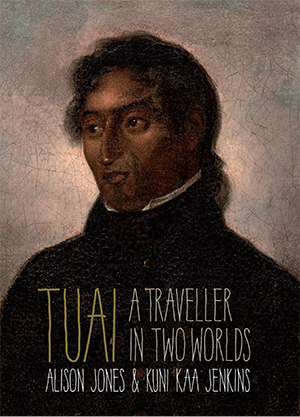 This sumptuous book opens with two French artworks, both showing Tuai, then about 27 years old, standing in a waka in the south-eastern Bay of Islands. Tuai is from “the ancient Ngare Raumati iwi”, and the large fortified pā, Kahuwera. By the year’s end he would be dead. This book tells his story – a man who emphatically belonged in the Māori world, yet was one of the first generation of Māori to travel voluntarily and confidently overseas. Tuai heard stories from returning travellers, European explorers, traders, and missionaries; and in early 1817 he set off for England on an epic journey – his OE of discovery of that time. He became a leader who attempted to bring his people and Europeans together in a respectful and equitable way. The book suggests that he was one of the first so-called “modern” Māori, who acquired the trappings of European culture including friendships and knowledge, without losing his manawa Māori.
This sumptuous book opens with two French artworks, both showing Tuai, then about 27 years old, standing in a waka in the south-eastern Bay of Islands. Tuai is from “the ancient Ngare Raumati iwi”, and the large fortified pā, Kahuwera. By the year’s end he would be dead. This book tells his story – a man who emphatically belonged in the Māori world, yet was one of the first generation of Māori to travel voluntarily and confidently overseas. Tuai heard stories from returning travellers, European explorers, traders, and missionaries; and in early 1817 he set off for England on an epic journey – his OE of discovery of that time. He became a leader who attempted to bring his people and Europeans together in a respectful and equitable way. The book suggests that he was one of the first so-called “modern” Māori, who acquired the trappings of European culture including friendships and knowledge, without losing his manawa Māori.
His older brother Korokoro encouraged Tuai to travel overseas, first to Australia and then further afield to England. Tuai became friends in Parramatta with another young Māori man, Tītere, and arranged a passage for them both to travel to England in April 1817 on the brig Kangaroo. The ship’s master had other ideas however, and detoured via Tasmania for some extra-legal activities. The ship became leaky and had to be nursed along the east coast of Australia, and after very rough weather, needed repairs in Batavia (Jakarta), finally arriving in London in February 1818, ten months later.
Staying as guests of the Church Missionary Society with clergy, initially in London and later moving to the north-west, Tuai and Tītere saw many of industrial England’s secrets of iron-making, pottery, and the working classes. They learnt to use tools and to surprise the citizens of Shropshire with “the presence of surprisingly polite and intelligent cannibals.” Gradually, after many experiences, they realised that Pākehā such as missionaries were only interested in coming to New Zealand to propose changes to Māori society. Hoping to get back to New Zealand before the next English winter – Tuai had been very sick the previous one – they embarked in December 1818 as paying passengers on a convict ship bound for Australia, on a voyage plagued by misadventure. Eventually they set sail again at the end of January, reaching Sydney at the end of June 1819.
It seemed Tuai had not succeeded with trying to meet Europeans halfway. He was still a Māori who held strongly to his spiritual and customary beliefs, and therefore not European enough. But his clothing was an unambiguous sign that he had been permanently changed by his adventures. For all that, he was unable to help his people to integrate the new arrivals into te ao Māori. But this is a very readable and engrossing tale of grasping opportunities when offered, and the politics around the often-fatal encounters between Europeans and Māori before Te Tiriti was signed, when Māori still had the advantage of numbers.
 Gerry Te Kapa Coates (Ngāi Tahu, Waihao) was born in Ōāmaru, and has had poems, book, and theatre reviews and stories in Huia Short Stories collections 4, 5, and 7; and other publications including Landfall, Mana magazine and Ora Nui 3, as well as a wide variety of non-fiction espousing environmental issues, amongst other themes. His collection of poems and short stories from 1961–2011,The View From Up There, was published by Steele Roberts. Gerry was a panellist at the 2013 Christchurch Writers and Readers Festival. He also works as a consultant and commissioner on RMA and similar EPA hearings, as well as being an author and doing Māori and technology advisory work.
Gerry Te Kapa Coates (Ngāi Tahu, Waihao) was born in Ōāmaru, and has had poems, book, and theatre reviews and stories in Huia Short Stories collections 4, 5, and 7; and other publications including Landfall, Mana magazine and Ora Nui 3, as well as a wide variety of non-fiction espousing environmental issues, amongst other themes. His collection of poems and short stories from 1961–2011,The View From Up There, was published by Steele Roberts. Gerry was a panellist at the 2013 Christchurch Writers and Readers Festival. He also works as a consultant and commissioner on RMA and similar EPA hearings, as well as being an author and doing Māori and technology advisory work.
The New Zealand Project
Nā Max Harris
Bridget Williams Books
RRP: $39.99
Review nā Mark Revington
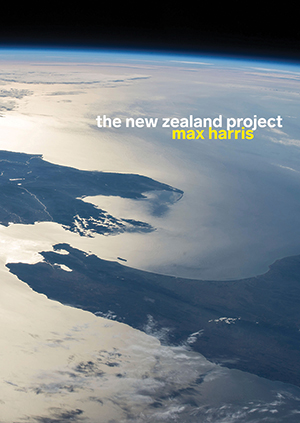 The New Zealand Project has been out long enough for some interesting opinions to circulate, probably not helped by the blurb on the back that describes author Max Harris as a “brilliant young New Zealander”.
The New Zealand Project has been out long enough for some interesting opinions to circulate, probably not helped by the blurb on the back that describes author Max Harris as a “brilliant young New Zealander”.
There seem to be two perspectives – one that the book has interesting ideas but is a little removed and academic, and another that Harris calls for a change in the way this country confronts politics is well-researched and authentic.
Personally, I like his call for the re-emergence of values-based politics which include care, community, and creativity; and I think we are reaching a tipping point where the politics of individualism and greed are cast aside. If that makes me, like the author, “unashamedly idealistic”, well so be it. I happen to believe, like Max Harris, that we face some monumental challenges in the form of climate change and wealth inequality, to name a couple; and the way humanity responds now is incredibly important for future generations.
You don’t have to agree with everything that Max Harris believes in, but it’s hard to disagree with the idea that politics is ultimately about us, and the kind of country we want.
 Mark Revington is a Pou Tokomārama in the Tribal Economies team at Te Rūnanga o Ngāi Tahu. He is a former editor of TE KARAKA.
Mark Revington is a Pou Tokomārama in the Tribal Economies team at Te Rūnanga o Ngāi Tahu. He is a former editor of TE KARAKA.
Tears of Rangi: Experiments Across Worlds
Nā Dame Anne Salmond
Auckland University Press 2017
RRP: $65.00
Review nā Sampson Karst
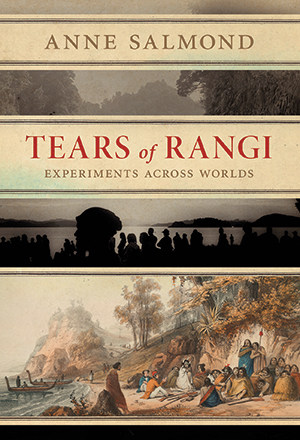 I once heard Tā Tipene O’Regan say that the most enduring characteristic of Māori is our capacity for dynamic adaptation. Our journey from Polynesia in the Central Pacific through the rainforests of Te Waipounamu, right down to the tītī islands north of the Antarctic, was a passage of travel that made us Māori.
I once heard Tā Tipene O’Regan say that the most enduring characteristic of Māori is our capacity for dynamic adaptation. Our journey from Polynesia in the Central Pacific through the rainforests of Te Waipounamu, right down to the tītī islands north of the Antarctic, was a passage of travel that made us Māori.
In her new book, Dame Anne Salmond explores this innate ability to accommodate change as we made contact with the western world. Salmond has written extensively on this subject, and starts by revisiting the period of early contact where ground rules were established for trade and commerce, and the knowledge systems that first came to interact. This section also deals with the first missionaries to arrive on our shores, and the impacts they had on our own system of polytheistic religion, where multiple deities were afforded forms of worship. The second half of the book delves into specific themes, such as our fragile native ecosystem, our rivers and ocean, and social constructs that have been influenced by our past and continue to reverberate into the present. When members of the east coast iwi, Te Aitanga-a-Hauiti, saw the Endeavour offshore nearly 250 years ago, they had to decide if the visitors would be welcomed. In 2011, when oil exploration vessels arrived in the same waters, they were met with hostility. Each chapter of events offers insights into the values, principles, and philosophies of the parties at play.
Salmond’s passion for environmental issues shines through, as she shares personal stories of her role in this arena. A detailed and well-researched historical account is to be expected of this award-winning author. Prior knowledge of our turbulent colonial past or the Treaty of Waitangi is not required to enjoy Tears of Rangi: Experiments Across Worlds, because Salmond acts as a guide through these chapters, presenting the facts as they unfold. One of my favourite parts of the book was one that showed portions of personal journal entries and correspondence between key characters. These excerpts offer a window into the social, cultural, and economic factors at play during crucial crossroads in our history.
This latest offering by Dame Anne Salmond will delight anyone with an interest in the history of our young country. I found I was able to enjoy the ride, and refrain from “cheerleading” for the Māori voice that is active and vibrant in her story. Salmond makes this easy, because she leaves no rock unturned in an effort to gain a comprehensive understanding of the echo of events that are our past. Her trademark gift for recounting events while drawing a line of continuity to the present makes for a captivating read.
 Sampson Karst (Ngāti Irakehu, Ngāti Mako) works for Te Rūnanga o Ngāi Tahu as a content creator in the Communications team. He lives in Christchurch with his wife Charlotte and son Ollie.
Sampson Karst (Ngāti Irakehu, Ngāti Mako) works for Te Rūnanga o Ngāi Tahu as a content creator in the Communications team. He lives in Christchurch with his wife Charlotte and son Ollie.
Opinions expressed in REVIEWS are those of the writers and are not necessarily endorsed by Te Rūnanga o Ngāi Tahu.